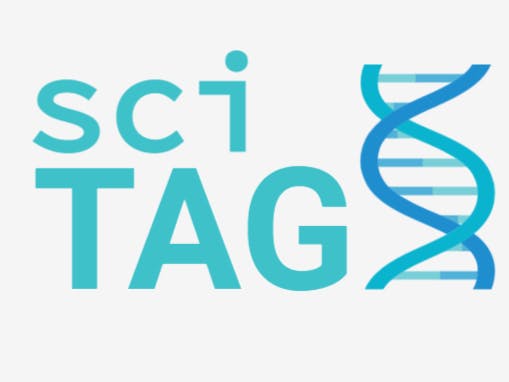We envisaged an app which is user-friendly, automated, and compatible with affordable label printers. To accomplish our goal, we followed a stepwise approach composed of three parts: user interface design, technical structure of the app and testing the app. As a team of five, we split the workload and meet virtually every week for progress updates. We started by self-teaching ourselves how to design and develop an app since most of us never worked on app development before.
User Interface Design: Interface design decisions were made not only to be attractive to potential users, but also to be functional and simplistic as possible. One aspect of the design is visual elements. We decided on aesthetic choices such as color scheme throughout the app. We considered colour blindness since 4.5% of the global population experience colour-blindness. Next, we decided on the name of the app: sciTAG. We did a market research to make sure this name is not a trademark. Finally, we designed an app logo depicting a double-stranded DNA alongside the name of the app.
Then, we identified the features that are crucial for our target audience. We divided the label design into two blocks by keeping it as simple as possible with choices included to create a good label.
Drawback: At this stage we did not encounter major difficulties.
App Development: A Github profile was created to share and update progress throughout the project. Technical structure of the app layered as follows:
● create an object with all user input information from the form
● convert the object to a printable object (e.g. PDF)
● convert the object to a storable/shareable object (e.g. csv)
● directly print the label from the app using Airprint option
Drawback: We were able to successfully create a form in which the user is able to input all the information including: sample name, date, username and additional information. The additional information section will be expanded and moderated according to the different label types. Our first simple label was designed for cryotubes commonly used in the laboratory setting for long term storage. We were able to successfully save the user input, however we were struggling to create a printable object. We considered using a PDFKit, labelUI, and UIimage. All options seem as a potential solution to our problem but as our app is novel in the approach, it’s been challenging to develop this part of the code from scratch.
Testing the sciTAG app prototype: We sourced several label printers available in the market to test sciTAG app. Among these printers only one of them is specific for lab settings (Brady BMP51). Other printers we have tested are sourced from Amazon, and they are highly affordable. We distributed these printers within the team to individually test and report our experiences. In this part of the project, we also extended our market research and used several apps (workstation or mobile) to identify the elements of these apps that are lacking envisioned features or using features we would like to have in our app.
Drawback: Although we managed to develop the prototype, we still need to work on this prototype to have a fully functional app.
In conclusion, we think sciTAG app along with affordable label printers would be a practical solution to scientists. We are planning to test the alpha app by recruiting five laboratories in Cambridge at the first round of testing.





Comments
Please log in or sign up to comment.